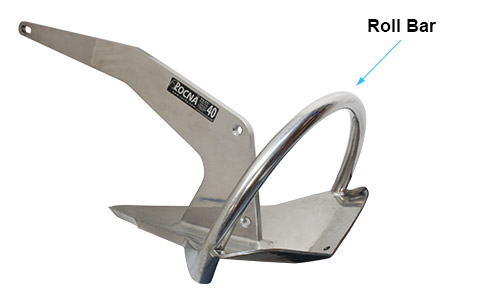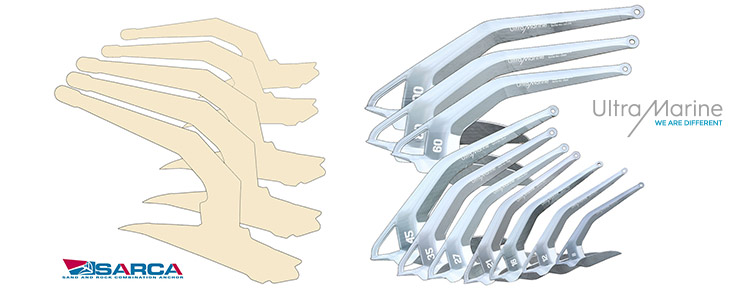How To Choose A Main Anchor
When it comes to purchasing a new bower (main) anchor, you need to be clear about why you are replacing the existing one so you can focus on the primary selection criteria:
Like for Like Replacement or Upgrade?
Hot Dip Galvanised or Stainless Steel?
What Size Anchor?
Which Design and Model?
Your Anchor Budget
Performance Requirement
Bow Roller Compatibility
Like for Like Replacement or Upgrade?
Your answer depends on why you have decided to make the change.
Straight Replacement
If you are happy with your current anchoring but are fed up with the rust, do a straight swap for the same one. Keeping the same design and weight will mean you can be sure it will be a suitable fit.
Earlier designs like the Lewmar Delta are still available: Lewmar Delta
And Lewmar produces a decent copy of the Bruce: Lewmar Claw
Re-galvanising may also be an option if you can find a local treatment plant, but the replacement versions of the older designs are reasonably priced. They are also available in stainless if you want to switch up a gleaming finish.
Is your Anchor Undersized? Oversized? Or Just About Right?
Most anchor manufacturers publish a weight guide according to the length of your boat, and some manufacturers also add displacement, windage and wind speed to their recommendations.
Continuing with the same anchor, even in a size up or down, will greatly improve the chances that it will be compatible with your bow roller.
Have you been dragging the anchor or experiencing any other anchoring issues?
If you have been experiencing issues with the current setup, it will be advisable to assess your anchoring system as a whole because there may be other parts of the anchor rode that are contributing to any issues, prompting you to consider an upgrade to your anchor:
Are you planning an extended cruise?
Liveaboard anchoring will mean that the safety of you, your crew and your yacht will heavily rely on your anchoring capability.
Hot Dip Galvanised or Stainless Steel?
Stainless Steel
Stainless steel is much more expensive than Hot Dip Galvanising and may make too big a hole in your overall yachting budget.
Stainless steel can clear itself of mud and debris more readily than galvanised which can be advantageous.
Please note that staining may appear on stainless steel in a salty marine environment, despite the inference in the name.
Happily, there are effective cleaning agents available to restore all your stainless.

Super Stainless is simple to apply with no need for scrubbing or polishing.
Purpose-designed stainless steel anchors and stainless versions of many galvanised anchor brands are available.
N.B. Stainless and galvanised mild steel have different strength and resistance properties, so from an engineering viewpoint, it may be prudent to select an anchor designed for a specific type of steel.

The purpose-designed Stainless Ultra. The Delta is an anchor that may have originally been designed for Galvanised.
Browse our range of:
Hot Dip Galvanising
Hot Dip Galvanising is not just a surface treatment. Hot Dip means immersion in molten zinc, resulting in a chemical reaction that infuses the zinc deep into the steel.
Read more on Galvanising:
Galvanising: The Treatment Process Explained
Galvanising: Managing Performance and Endurance Expectations
Galvanising will eventually go rusty due to the abrasive nature of anchoring, but it should be a gradual process over multiple years of deployment and retrieval. There are also cold galvanising zinc sprays available for dealing with any blemishes.
If only a pristine anchor on the bow roller of your pride and joy will make you happy, stainless steel may be your best option because galvanising will begin to exhibit signs of oxidisation and corrosion after a surprisingly short period of service.
Browse our range of: Galvanised Anchors
Combining Galvanised with Stainless in your Anchoring System
Mixing the two steels is commonplace in yachting. However, any combination should be regularly checked for signs of a galvanic reaction, e.g. stainless steel shackles or anchor connectors joining a galvanised chain to a galvanised anchor.
Stainless is a nobler metal than mild steel, so expect the galvanic corrosion to affect the galvanising. Relative mass is an important factor. The reaction is worse when the stainless part is much larger than the mild steel part, e.g. a stainless anchor with a galvanised shackle. Conversely, a large, galvanised anchor connected to a relatively small stainless-steel shackle shouldn’t be so bad.
For more information on galvanic reaction: Stainless Steel In Contact With Galvanised Steel
To summarise, a uniform grade of steel is advisable for anchor, connection, and chain if you want to avoid taking any chances on degradation or you are unwilling to commit to some maintenance.
What Size Anchor?
Manufacturer Guidelines
Narrow down the suitable size (or sizes) based on the anchor manufacturer, your yacht length, displacement and windage. Manufacturers publish recommendations for you to gauge your best options.
The Jimmy Green Team have collated a useful comparison guide based on the manufacturer’s recommendations:
Sailing Habits and Cruising Plans
Having interpreted the manufacturer guide as best you can (see above), the next step is to think carefully about your anticipated cruising and anchoring and how dependent you will be on the anchor for the well-being of you and your yacht.
Similar-Sized Yachts
You could also check what other similar yachts are carrying and listen to what other skippers and owners suggest before you make up your mind.
World Cruising
Upsizing your preferred choice for global cruising is worth considering if you can accommodate a bigger anchor on the bow and your budget allows it.
How much you may depend on your anchoring setup to secure your yacht in extremis should have a major bearing on your decision. Your anchoring capability may make the difference between holding and dragging on a lee shore.
N.B. Ensure that all your anchoring system, not just your anchor, is comparably robust and that the windlass is powerful enough to retrieve the anchor.
Read more on our Anchor To Chain Connection Guide
Which Anchor Design and Model?
Research a Shortlist
It is a good idea to learn about all the up-to-date anchors online. Check out the anchor reviews and comparison tests, bearing in mind they may not be entirely independent.
“Time spent on reconnaissance is seldom wasted.”
Research your subject, remembering that all the information you find may only be partially objective and that anchor tests are simulations, not the real thing.
Watch the anchor videos. Read about the tests ‘with a pinch of salt’. Decide which pros and cons are important to you.
Think about which functions matter the most for your circumstances, e.g.
- Minimum break-out potential
- Self-setting ability
- Holding power in your probable anchorages
- Resetting capability in the event of big tide and wind shifts
- Mud and debris shedding characteristics
- Arrival into the bow roller the right way up
- Roll bar compatibility
- Rust-free aesthetics
Roll Bars
Roll bars help the anchor turn over to the correct orientation, but they are cumbersome and awkward to work around.

Geometric Design, Weighted Tips and Lighter Shanks
Some modern anchors are designed to attain the same ‘roll and ready to penetrate’ attributes with advanced geometrics, weighted chisel tips and lighter shanks.
Retrieval Orientation
Some anchor shapes may be more suited to arriving at the bow roller in the right orientation. However, flip and swivel anchor connectors can address this issue if your preferred choice stubbornly refuses to appear the right way up.
Browse our range of: Anchor Connectors
Decide on your Budget
Depending on what your online research reveals, this may need to be flexible. Make a note of the ballpark prices for each anchor model and size on your shortlist to narrow the options. Make a wish list based on how much of your overall yachting budget you are prepared to allocate to a new anchor.
Performance Requirement – what needs to improve?
If you have had issues anchoring in the past, what were the typical problems? e.g. setting failures, dragging calamities, retrieval or bow roller difficulties?
Pick an anchor that will make the most important improvements.
Bow Roller Compatibility
This is an all-important aspect of the whole process. You’ve identified what you believe is the best anchor for you, but will it fit?
You will presumably want to avoid making any alterations to the stemhead fitting, the bow roller or the foredeck layout. Still, if you are considering any other upgrades, such as adding a bowsprit and top-down furler, this may mean some work on the bow and foredeck, anyway.
Checking whether your preferred anchor will fit on your bow may be a little daunting, but here are some pointers to help you succeed.
Jimmy Green Marine can supply single-plane, actual-size, paper templates or card templates for most top-level anchor designs. This should give you a good indication of whether it will be suitable.
e.g.
Sarca Excel Anchor Profile Templates

However, templates don’t address three-dimensional sizing.
Roll bars can interfere with the sails and rigging at the bow and on the foredeck or affect any lines leading forward to the bowsprit.
Ultra Marine may have your yacht in their database of successful installations. Which may give you added assurance, especially for such a large investment.
You can try quartering your local marina for a helpful example to check a particular dimension, or, if you are lucky, find a yacht owner who will lend you their anchor to try out on your bow.
Ultimately, you may have no option but to make your purchase to check the fit.
Purchase Planning
Price is always a key factor, but buying the cheapest is not always the best solution, even in a like-for-like comparison.
The Jimmy Green Team take pride in all aspects of customer service, whether you are making an initial enquiry, seeking an extra nugget of information not readily accessible, or needing after-sales attention.
You can be confident that Jimmy Green Marine will represent you if there are any warranty issues.
Jimmy Green Marine specialises in anchoring, and a good stock of all our top anchors means we can answer most questions or check any dimensions for you.
If you are still not 100% certain that the anchor will fit, please read our Returns Policy.
Here are the basics:
- You have 14 days to try the anchor and inform us in writing that it doesn’t fit to qualify for a refund.
- You have up to one calendar month to qualify for a credit voucher on your account.
- You have 14 days to return the anchor to our premises from when you informed us.
- Vouchers can be set against another anchor or other products on our website.
One word of caution: take great care not to damage the anchor when trying it on the bow roller. Any scratches or marks will affect your right to a return.
Summary Checklist – Nine Questions to Answer Before Buying an Anchor
- Will it be a like-for-like replacement or an upgrade?
- Do you prefer Hot Dip Galvanised and Stainless Steel?
- What size does the manufacturer recommend?
- From your research, which anchor designs and models appeal to you?
- How much do you want to spend?
- What are the most important design features for you?
- Will the anchor fit on your bow roller?
- Who is an anchoring specialist retailer?
- Should you put your trust in Jimmy Green?













